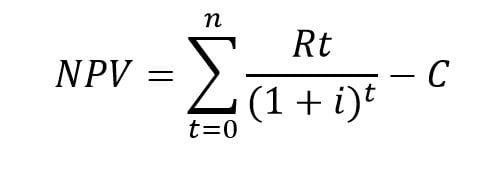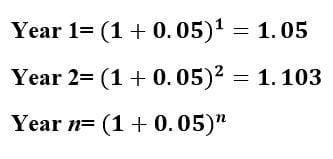It is no secret that investment property analysis is the key to success in the real estate investing world. As a beginner real estate investor, you have probably already learned a lot about finding the best real estate investments and using tools such as the investment property calculator. But have you heard about one of the most useful real estate calculations- the net present value of investment property and the net present value formula? No? Do not worry! In this blog, we will reveal everything you need to know about the NPV, how to calculate it, and how to use it wisely.
#1 What Is Net Present Value in Real Estate?
The net present value calculation, in general, indicates the current value of all upcoming cash flows which are generated by the investment. The net present value formula takes into consideration the time value of money on the basis of one simple principle. It states that the current value of a specific amount of money is higher today than it would be in the future. This is simply because the money could have been invested in a different opportunity and generated even higher profit in time.
In other words, the net present value formula calculates the present value of cash flows (cash inflows minus cash outflows) over a given period of time. Calculating net present value is necessary in different industries to analyze the cost-effectiveness of an estimated investment. Real estate investors use the metric to predict if the chosen investment property will actually generate the rate of return they would like it to.
Related: A Beginner’s Guide on Calculating the Net Present Value of an Investment Property
#2 The Net Present Value Formula
It is of crucial importance to review and understand all components of the net present value formula before proceeding to calculate the actual value. Even though the formula of this real estate metric might look scary and quite complicated, stick with us as it will bring you beneficial information for buying an income property.

Here is a breakdown of the net present value formula that will help you understand a bit better what is actually going on in this complicated equation.
- Rt- This is the net cash flow or the cash inflow minus the cash outflow for a specific time period.
- i- This is the discount rate. When exploring real estate investment opportunities, this value typically represents the desired rate of return.
- t- This stands for the number of time periods that will be calculated.
- C- This value represents the initial cash investment.
#3 How to Calculate Net Present Value
After seeing the net present value formula, it is logical to start wondering how to calculate net present value. Well, we have you covered. Here are the most essential steps real estate investors should take in order to be successful in calculating net present value.
-
Select Potential Real Estate Investment Opportunities
First of all, you should choose a potential investment property you would like to own and manage. This will also help you in estimating the cash inflow for a specific period of time. For instance, the rent is typically 0.8% to 1% of the current market value of the investment property.
-
Establish the Financing Method
Secondly, you should know how you are going to finance your investment property. If you pay the whole investment in cash, the calculations will differ from having a mortgage loan. If you pay the whole property price at once, that price will be your initial investment number, marked as C in the formula. If you have a mortgage, the down payment will be the initial investment, while the monthly payments fall into the category of Rt- in other words, the outflowing cash.
Related: Discover the Most Popular Real Estate Financing Methods
-
Choose the Desired Rate of Return
Choosing the desired rate of return is a crucial step in calculating the net present value of an investment property. After all, the whole purpose of this real estate calculation is determining whether or not the income property will be able to generate that desired rate of return, otherwise known as i in the formula. This step should be tackled carefully, as choosing the desired rate depends on the area, type of property, risk factors, etc.
Related: How to Use the Net Present Value in Real Estate Investing Calculations
#4 Calculating Net Present Value: Example
Finally, the time has come to show the net present value formula in action by providing you with a net present value example. By seeing how to actually use the net present value formula, the whole concept of the metric becomes clearer and easier to approach.
Let’s imagine that you are interested in buying an investment property that costs $150,000. You have saved $50,000 and you are ready to invest them in the property. For the rest of the money, you take out a mortgage loan which you will pay over 10 years with a monthly payment of $850. Additionally, you have decided to run the property as a long term rental and to charge $1,500 for monthly rent. Last but not least, you have selected a desired rate of return of 5% for your investment.
*When calculating the values in the example, it is assumed that the rental property will be occupied at all times. Additionally, the value of the real estate investment after the selected time period has not been considered.
In this example, the values will be as follows:
- Rt = ($1,500- $850) x 12
- Rt = $650 x 12
- Rt = $7,800
We multiply the value by 12 in order to get the cash flow for the time period of one year.
- i = 5% = 0.05
- t = 10 (years)
- C = $50,000
Now that we know all the variables that are needed in the net present value calculation, it is time to do some math. We need to calculate the discounted cash flow for each period of time and then add them together. Discounted cash flow means that we will divide the cash flow over the computation of the desired rate of return. In the end, we will subtract the initial investment to find the NPV value for this specific example. Let’s begin by calculating the desired rate of return for every single period of time.

After that, it is necessary to compute the discounted cash flow for each time frame.
Year 1 = $7,800/1.05 = $7,429
Year 2 = $7,800/1.103 = $7,075
Here is a table that illustrates all the values for each time period.
| Yearly Cash Flow | Desired Rate of Return | Discounted Cash Flows | |
| Year 1 | $7,800.00 | 1.05 | $7,429 |
| Year 2 | $7,800.00 | 1.103 | $7,075 |
| Year 3 | $7,800.00 | 1.158 | $6,738 |
| Year 4 | $7,800.00 | 1.216 | $6,417 |
| Year 5 | $7,800.00 | 1.276 | $6,112 |
| Year 6 | $7,800.00 | 1.340 | $5,820 |
| Year 7 | $7,800.00 | 1.407 | $5,543 |
| Year 8 | $7,800.00 | 1.477 | $5,279 |
| Year 9 | $7,800.00 | 1.551 | $5,028 |
| Year 10 | $7,800.00 | 1.629 | $4,789 |
One of the last steps is adding up all the discounted cash flow values. In our case, it would look like this:
SUM = $7,429+$7,075+…+$4,789
SUM = $60,230
Finally, it is time for calculating the NPV value by subtracting the initial investment from the sum of all discounted cash flows:
NPV = $60,230-$50,000
NPV = $10,230
#5 Net Present Value Results
Once we have calculated the net present value, it is important to know what the results tell us. There are three possible scenarios:
-
NPV <0
If the net present value is lower than zero, this simply means that the investment property of your interest would not be able to generate the desired rate of return you have set up.
-
NPV=0
If the net present value equals zero, this implies that the selected real estate investment will exactly produce the desired cash flow. This is due to the fact that the discounted cash flow value equals the initial cash investment.
-
NPV>0
If the net present value is higher than zero, your investment property will potentially achieve a higher rate of return than the one you desire.
Conclusion
To sum it up, it is not so easy to get the hang of using the net present value formula. However, once you do, you can use this real estate metric to seek the best real estate investment opportunities. However, don’t forget that you should never rely on a single number or calculation when choosing an investment property.
You can turn to Mashvisor’s real estate investing tools in order to get a complete investment property analysis that you can rely on. To learn more about how we will help you make faster and smarter real estate investment decisions, click here.